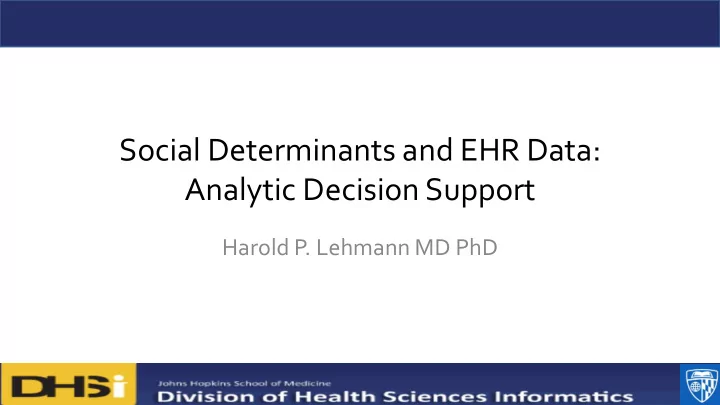

Social Determinants and EHR Data: Analytic Decision Support Harold P. Lehmann MD PhD
The PaTH Clinical Data Research Network PCORnet Common Data Model Database
Patrick Ryan, Observational Health Data Sciences and Informatics (OHDSI) Overview, 5/14/14 Courtesy Kelly Gleason
Patrick Ryan, Observational Health Data Sciences and Informatics (OHDSI) Overview, 5/14/14 Courtesy Kelly Gleason
Challenge “ How do I convince hard- boiled researchers that our results are as http://skepticwiki.org/ trustworthy and believable as the best epidemiological data? Dan Ford
Where ’ s the Population? Sen A, et al. GIST 2.0: A scalable multi- trait metric for quantifying population representativeness of individual clinical studies. J Biomed Inform. 2016 Oct;63:325-336.
What ’ s the • Do all the fields with the same name mean the same thing? “ diagnosis ” ? The case atrial Billing 18,731 Encounter 15,774 fibrillation 850 4,500 14,456 10,789 33,314 2,659 1,986 11,054 Problem List 25,608
Some Potential Biases Diagnostic Suspicion Bias Ascertainment/ Diagnostic/ (Survivor) Misclassification/ Treatment Treatment Competing Detection Bias Access Bias Bias Risks Sick-Quitter Spectrum Bias Healthcare Lead time/ Bias Protopathic Access Bias Observed Observed Bias Outcome Outcome Gaps in Observable Data Outcome Computable General Healthcare EHR Temporal Cohort Population Population Population Ambiguity <Exposure> Recorded Outcome Berkson’ s Patient- Bias Reported Referral Spectrum Outcome Filter Bias Centripetal Bias Bias Inclusion/ Non- Exclusion Bias Response Length Under-reporting/ Bias Bias Recall Bias Semantic Uncertainty
Amateur Analysts • Too many analysts to train them all at the level we want MACRA, eCQM, Pop Health, PMI, … • Analyses are the most complicated • No funds for proper statistical analysis Rube Goldberg • Statistical-analytic decision support is needed • We need to convert methodological knowledge into computer-readable form
“ Workforce According to the McKinsey report, the United States will need an additional 140,000 to 190,000 data science experts with “ deep analytical skills, ” plus 1.5 million managers capable of using data analytics in decision making. BHEF Issue Brief . 2014 http://files.eric.ed.gov/fulltext/ED55964 0.pdf klipd.com
Decision Support Cycle
Decision Support Cycle Data set Analyst ’ s Knowledge
Analysis “ Intelligent By 1995 or so, the largest single driving force in Assistance guiding general work on data analysis and statistics and Data [will be] to understand and improve data-analytic expert systems …” John Tukey, 1986
Early History • 1983: Nedler: Front-end system (for GLIM) • 1984: Gale, Pregiborn: REX: Advise on linear regression • 1985: Hahn defines levels of intelligence: simple computerized answering → automated statistical consulting • 1988: Duijsens: PRINCE helps naïve users formulate analysis options • 1988: Oldford & Peters: DINDE: graphical environment tracks steps • 1989: Chowdury: MAXITAB for inexperienced users for data analysis and interpretation • 1994: Silvers et al.: PROPHET: Beyond Anova • Silvers, 1994
Knowledge Cycle Lehmann HP, Downs SM. Desiderata for Computable Biomedical Knowledge for Learning Health Systems. Learn Heal Syst. 2018;e10065:1 – 9.
Desiderata Desiderata Development Work to Be Done • Measures that take clinical thresholds into account 70,71 1. Discrimination • for Elicitation and articulation of those thresholds • Methods for recalculating local discrimination • Application of calibration based on thresholds 17 2. Local Recalibration Computable • 3. Thresholds & Local Elicitation, articulation of preferences • Preferences Local calculation of thresholds Biomedical • 4. Explanation Deployment • Choose variables based on value of information 72 5. Monitoring Knowledge • 6. Debiasing Creation and curation of debiasing models • Application of debiasing models for Learning • Calculation of distance 62 7. Generalizability • Adding to the Knowledge Artifact the meta data required Health to choose the calculation • 8. Semantic Derivation of the epistemic confidence interval Systems Uncertainty • 9. Findable Articulation of the full ontology required to index a Knowledge Artifact at all its multiple levels • Tagging KO with that ontology Lehmann HP, Downs SM. Desiderata for • Computable Biomedical Knowledge for 10. Other Continuous monitoring and improvement of these Learning Health Systems. Learn Heal Syst. Commandments as desiderata 2018;e10065:1 – 9. necessary and proper
Ontology for Biases: Extensions to OCRe H Lehmann, T Darden, G Williams. 2014. Unpublished.
To Do • Methodology for the analysts • Knowledge tools to store the knowledge • Knowledge tools to apply the knowledge • Combine JH/PaTH/Israeli expertise
Recommend
More recommend